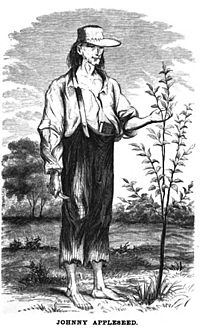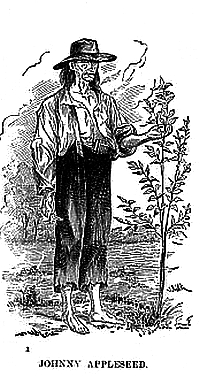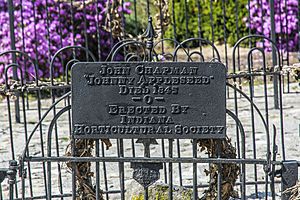Johnny Appleseed facts for kids
John Chapman (born September 26, 1774 – died March 18, 1845) is much better known as Johnny Appleseed. He was an American pioneer who planted many apple trees across a large part of the United States. He helped introduce apple trees to areas like Pennsylvania, Ontario, Ohio, Indiana, and Illinois. He also planted trees in the northern parts of what is now West Virginia.
Johnny Appleseed became a legend even while he was still alive. People admired him for his kindness, generosity, and his work in protecting nature. He also believed apples were very important.
He was also a missionary for The New Church, which is a Christian religion. Many museums and historical places are inspired by him. These include the Johnny Appleseed Museum in Urbana, Ohio, and the Johnny Appleseed Heritage Center in Ashland County, Ohio. The Fort Wayne TinCaps, a minor league baseball team, are named in his honor. Chapman spent his last years in Fort Wayne, Indiana.
Contents
Johnny Appleseed's Story
His Early Life and Dream
John Chapman was born in Leominster, Massachusetts. Today, there is a special stone marker at his birthplace. The street there is even called Johnny Appleseed Lane. John started learning about growing plants from a man named Mr. Crawford. Mr. Crawford had apple orchards, and this inspired John to spend his life planting apple trees.
Many people think Johnny Appleseed just threw apple seeds everywhere. But he actually planted special nurseries (places where young trees are grown). He built fences around them to keep animals away. He would then leave the nurseries with a neighbor who would sell the trees. Johnny would return every year or two to take care of his young trees.
His very first nursery was planted near Warren, Pennsylvania. Later, he moved to Venango County and along French Creek. Many of his nurseries were in the Mohican area of north-central Ohio. This area included towns like Mansfield, Lisbon, and Loudonville.
He also planted a plant called dogfennel during his travels. He thought it was a useful plant for medicine. However, today it is seen as a weed that can take over other plants.
His Travels and Beliefs
As Johnny Appleseed traveled, he also shared his religious beliefs. He preached the gospel of The New Church. He met many Native Americans and admired them. The Native Americans saw him as a special person, touched by the Great Spirit. Even tribes that were not friendly to others left him alone.
He would tell stories to children and share his religious message with adults. In return, people often gave him a place to sleep for the night and sometimes a meal.
In his later life, Johnny Appleseed was a vegetarian. This means he did not eat meat. He never got married. He believed he would find his soulmate in heaven if he didn't find her on Earth.
His Last Days
There are different ideas about when Johnny Appleseed died. A newspaper called the Goshen Democrat reported his death on March 27, 1845. They said he died on March 18 of that year. The exact spot where he is buried is also debated.
However, in 1916, for Indiana's 100th birthday, a fence was put around his grave in the Archer graveyard. At that time, people who had been to his funeral were still alive. They helped make sure the grave was in the right place.
Johnny Appleseed's Legacy
Johnny Appleseed left behind many valuable nurseries when he died. He owned over 1,200 acres (490 ha) of land with young trees. He also owned land in Allen County, Indiana, and Mount Vernon, Ohio.
Festivals and Tributes
In Fort Wayne, Indiana, a special event called the Johnny Appleseed Festival has been held since 1975. It takes place every September in Johnny Appleseed Park. People dress in clothes from the early 1800s. They offer old-fashioned food and drinks.
In 2008, a minor league baseball team in Fort Wayne changed its name to the Fort Wayne TinCaps. The name "Tincaps" refers to the tin hat that Johnny Appleseed was said to have worn. Their team mascot is also named "Johnny."
In 1966, the U.S. Postal Service created a 5-cent stamp to honor Johnny Appleseed.
There is a memorial for him in Spring Grove Cemetery in Cincinnati, Ohio. It's a circular garden with a large stone. On the stone is a bronze statue of Chapman. He is looking up at the sky, holding a young apple tree and a book. A plaque explains who he was.
Celebrating Johnny Appleseed Day
Some people celebrate Johnny Appleseed Day on March 11 or September 26. The September date is his birthday. The March date is sometimes chosen because it's during the planting season.
There's a public school named Johnny Appleseed Elementary School in Leominster, Massachusetts, where he was born. The town of Lisbon, Ohio, also holds an annual Johnny Appleseed festival.
A large clay sculpture of Johnny Appleseed can be seen on the front of the Lakewood High School Civic Auditorium in Lakewood, Ohio.
Museums and Surviving Trees
Urbana University in Urbana, Ohio, has one of two Johnny Appleseed Museums in the world. It's open to the public. The museum has many items related to him, including a tree believed to have been planted by Johnny Appleseed himself. The museum helps people research his life and even find his relatives. It was updated in 2011. The museum hopes that learning about Johnny Appleseed will help people appreciate education, nature, peace, and good leadership.
It is believed that the only apple tree still alive that was planted by Johnny Appleseed grows on a farm in Nova, Ohio. Some people say it is a Rambo apple tree. However, Johnny Appleseed did not like to graft trees (joining parts of two trees together). He preferred wild apples. Nurseries now offer a "Johnny Appleseed" apple tree for planting. This type of apple ripens in September and is good for baking and making applesauce.
Images for kids
See also
 In Spanish: Johnny Appleseed para niños
In Spanish: Johnny Appleseed para niños











